In an earlier article, I have already made note of the transformation of Tipu Sultan into a Saint or a ‘Hazrath’. I have in this article, also mentioned of his great regard for the Sufi tradition of Islam.
Urs from the Arabic word for ‘wedding’ is the death anniversary of a Sufi saint in South Asia, usually held at the saint’s dargah or tomb. South Asians refer to their saints as lovers of God, the beloved. The death of a Sufi saint is regarded as a union with the beloved, and the death anniversary is celebrated as a wedding anniversary.
Tipu Sultan passed away fighting for his beloved Mysore, sword in hand, on the 4th of May, 1799. That is the 28th day of the month of Dhu al-Qi’dah, Hijri 1213. Dhu al-Qidah is the 11th month of the Arab/Islamic calendar while May is the 5th month in the English/Christian era; hence there is a difference of 7 years between his martyrdom according to the Islamic and English calendars.
The annual Urs celebration for the year 2012 was held at Seringapatam with great gusto and in the presence of an immense gathering on tuesday, October 16. I was fortunate to be a part of this gathering and pray at his graveside. It is my pleasure to share photographs of this procession that started from the Masjid-E-Ala, Tipu Sultan’s own mosque in Seringapatam and that culminated at the Gumbaz, where Tipu lies with his mother and father by his side.
The photograph below is taken from where the Juloos-E-Chadar (procession carrying the shroud that will be laid upon Tipu’s grave) originates. Here we see the the followers of the Sufi order mainly Chishtiya and Qalandaris with the colours of Tipu, namely the bubri plantain like design on the banners. A chauri or flywhisk bearer is holding a whisk of peacock feathers. Also note a mace bearer or ‘Chobdar’ carrying the mace of the state and another follower carrying an incense burner. I found this burner very interesting as it is definitely a relic from Tipu’s time having on it the ‘bubri’ or tiger – stripe relief struck out in brass. They wear jasmine garlands that have been presented to them by the Mufti of the Jumma Masjid.
Some among the procession are seen carrying clay pot decorated with flowers on their heads under an ornate umbrella. This pot that they hold so venerably contains the ‘Sandal’ or Sandalwood paste that will be used to plaster the stone tomb of Tipu. This Sandal paste will be later distributed to the gathering who will rub it onto their palms and apply it on their face. This is why the Urs is also often called the ‘Sandal’ of Tipu Sultan. The outer wall of the beautiful mosque is seen in the background.

The procession setting off from the Jumma Masjid at Seringapatam. Note the chobdar, chauri bearer and incense bearers here
As the procession began and started to wind it’s way to the Gumbaz, it was joined enroute by several smaller processions and groups of elated members, young and old, men, women and children. I will now show photographs of several of these groups many of them who show their affection to Tipu in myriad ways.

Children from the Jumma Masjid Madrasa-E-Tipu seen marching behind the Chador. Children from this Madrasa are taught the Qoran, Hadith along with languages like English, Kannada, Farsi and Arabic.
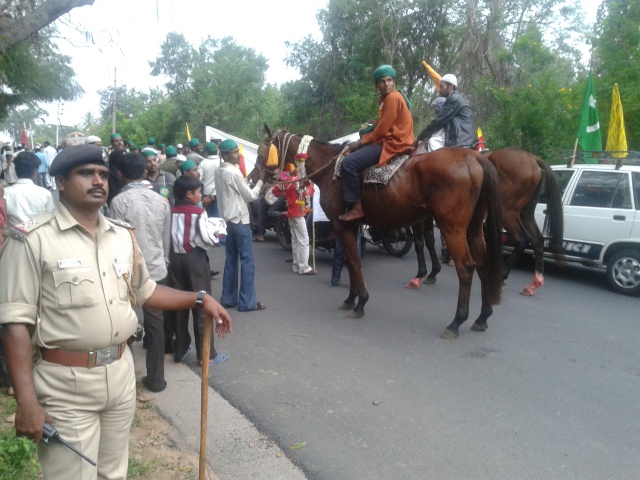
Horsemen at the procession. Arthur Wellesley, later Duke of Wellington complimented the Mysorean cavalry as the best he had fought against. After Tipu’s demise, his cavalry was integrated with the British forces and formed the nucleus of the Mysore Lancers that saw action under the British in various wars right from the Maratha campaigns in 1805 till the campaign in Abyssinia and Europe during WW1. Under Tipu Sultan this cavalry was called the ‘Silledar horse’ and had at it’s head Bakshi Bheem Rao.

The ‘Seringapatam Ox’ was among the best of Indian bred Oxen and was specially bred by the Mysore Government in Tipu’s time to haul large loads, especially light cannon over large distances without tiring and slowing the army. Lord Cornwallis lamented the poor quality of the British army’s draught cattle during his retreat from Seringapatam during the 3rd Mysore war.
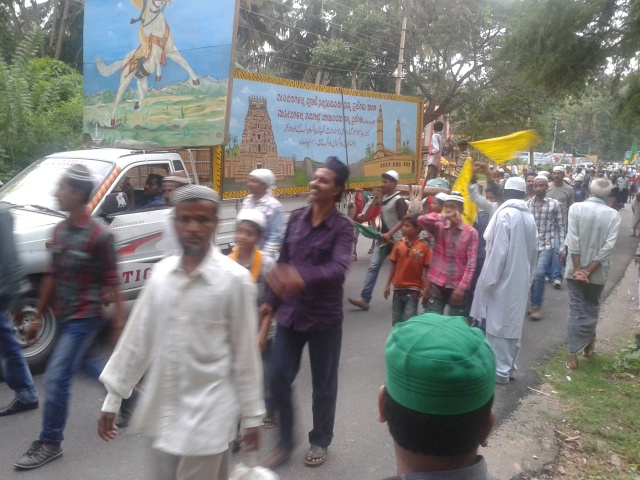
The writing on the tableaux in Kannada and Urdu reads:
” Among my subjects are they who pray in temples and they who pray in mosques” – Tipu Sultan

Observe the flags being carried by the devotees here. The flaming sun in a field of bubri – the flag of Tipu Sultan, the green flag of Islam and the red and yellow flag of the state of Karnataka. It was in Tipu’s time that Karnataka attained it’s largest geographical extant afater the demise of the Vijaynagar kingdom. Many Karnataka chauvinist organisations today carry the bust of Tipu on their banners during any important function.

Ladies participated in the procession with great fervour and did not balk at walking the entire 4 kilometer route
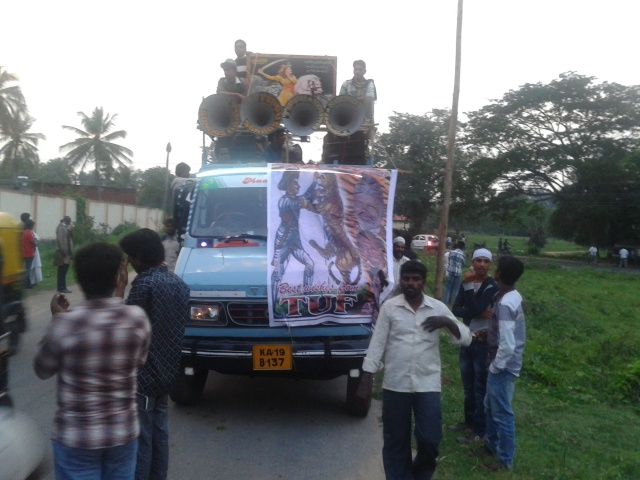
Tipu fighting the Tiger bare handed. It is not known if Tipu actually fought with a Tiger barehanded, however our iconography today has accepted this image of Tipu vs. Tiger almost as Gospel truth
It was nearing nightfall and the procession entered the town of Ganjam that contains Tipu’s summer palace, Dariya Daulat as well as his family mausoleum.
Drum beaters added to the whole occasion by playing lively beats on their drums as we reached the naggarkhana or the ‘drum house’ entrance
The chador and sandal were taken around the mausoleum several times amidst lively singing of songs praising the glory of Islam and the exploits of Tipu Sultan. People would touch the Chador whenever they got a chance to invoke Tipu’s blessings.
The crowd now streamed into the mausoleum where prayers were read over the graves of Tipu Sultan and his parents. The Sandal paste was applied over the tomb and chador laid over it. Sandal paste was later distributed to the gathering who received it with great veneration.
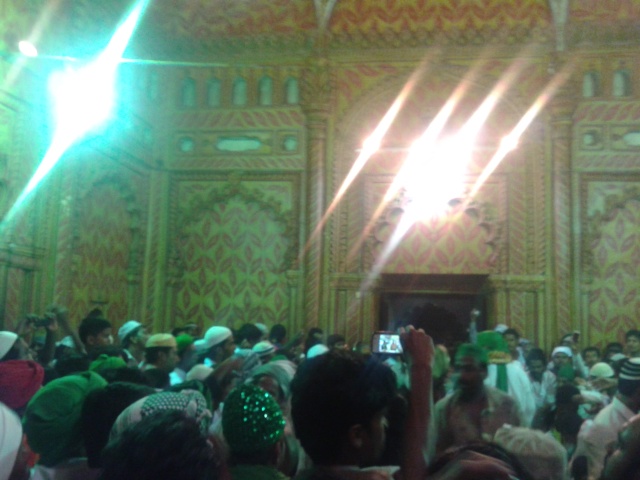
In the musoleum. Observe the bubri painted walls. The feeling of standing there next to where Tipu rests with over 10000 people around you is a feeling that has to be experienced to be felt
All around the mood was festive with the bright lights lighting up the extensive lawns around the mausoleum. A langar or community dinner was available to all devotees, many of whom had travelled from far to attend the Urs and many among whom would spend the whole night at the mausoleum praying, keeping vigil and later going to sleep, only departing for home next morning.
While the actual clebration was in progress here, a convocation function was held on the lawns with over 2000 people in attendance. The Tipu Sultan Madrasa at the Jumma Masjid was celebrating the passing out of 4 young graduates who passed out well versed in the Koran, Shariat and the Hadith. More than 30 different Ulema from Karnataka and the neighbouring states were in attendance, gracing the occasion.
The Mufti of the Jumma Masid Sajjad Hussain spoke of the efforts of the Madrasa -E- Tipu Sultan where an effort was made to churn out students who were well versed in the ways of God as well in a position to live in a secular polity. Students made presentations in Urdu, Arabic, English and Kannada. Religious songs or ‘Naat’ was presented by the youngsters. The main focus of this convocation function was to instill in the minds of all who attended the value of education and the importance that the Holy Prophet of Islam placed upon education with references being provided from the Koran and Hadith as well as references to Tipu Sultan’s commitment and interest in Education.
Obviously Mysore would not have been able to make rapid strides in Metallurgy, Gun Casting, Silk rearing, horticulture, rocketry, etc. under Tipu Sultan unless he did not propagate the latest developments in science and technology among his people. Not many know that Tipu had also proposed to send one of his sons to France to get an European education and also offered to teach one of the French Princes in India, in return.
It was indeed a wonderful experience retracing the footsteps of the last journey of Tipu Sultan on May 5, 1799 as his mortal remains were carrried from his palace at Seringapatam along the same road that the procession took today to where he was interred in the Gumbaz at Ganjam. He is not among us today, but his spirit will continue to stir all Indians to taking this country to the rightful place it should occupy in the comity of nations.
And it was also an honour for me to take you all with me along this photographic journey. Hope you had a nice time!





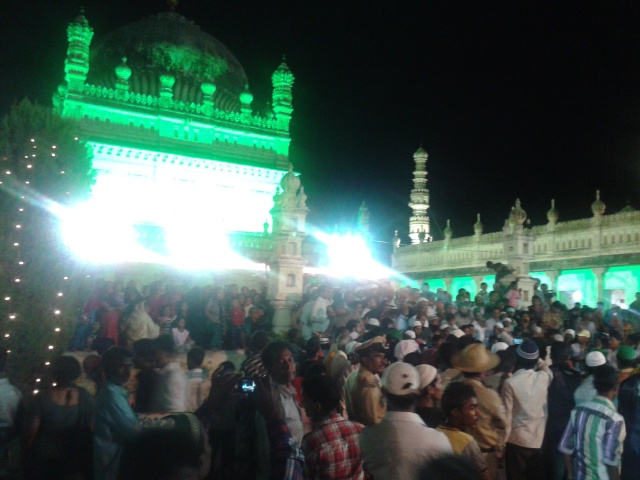
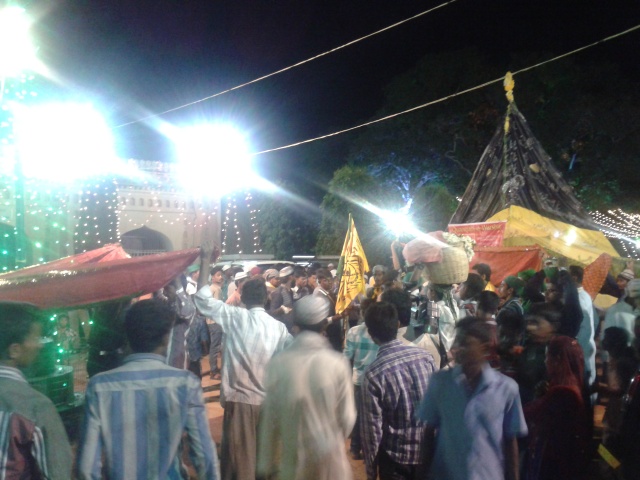


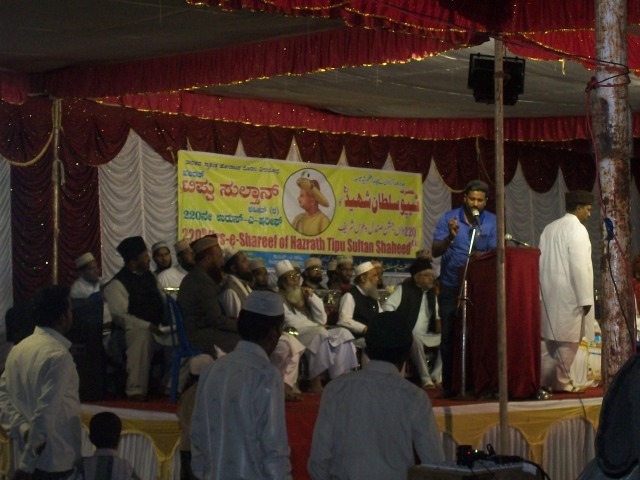
Wow, what a journey! Tipu’s followers mark his death anniversary like it was last year, not in 1799! I knew an Englishman who would fire an Indian cannon on Tipu’s death anniversary every year (until he also died), it just goes to show the respect Tipu demanded (and still does) all over the world! Thanks for the great pictures Nidhi.
olikara ! do u have any idea why keralites deeply dislike tippu sultan even today ? he tortured hindu kings there and killed many kerala men, captured beautiful hindu women for his janana and killed old people and children there . he looted the hindu wealth and declared ‘jihad” on them . still u think that tipusultan was a king who treated all religions equal? but keralites didnt think in the same way .
I agree with you Jaya here. Tipu has a far larger following in Karnataka than in Kerala.
When I write of Tipu, it is only from a Mysorean’s perspective and not anyone else’s.
For obvious reasons, the Keralite, Maratha, Hyderabad and British views on Tipu are different.
Well said Olikara, The Maratha, British and the Keralite were always known to be sworn enemies of Tipu for obvious reasons 🙂
DearS,this is a misunderstanding tipu sultan have treated all religions equal,he has presented many temples with gift which still exists,might be any other mughals have treated in a negative manner which has understood as tipus ill treatment.DONOT GET MISUNDERSTAND,HE HAS TREATED ALL EQUAL FOR WHICH HE IS STILL KNOWN FOR THIS GREAT ROLE IN ADMISTRATION. BRTISHERS STILL REMEMBER FOR HIS GREAT RULE & EQUAL TREATMENT & RESPECT TO ALL WOMEMS.
No Abdulla…. He was not a wise person He always trespass and looted the Maratha region too. He or any Muslim ruler never treated all regions equally…they always want to convert the people or loot on thee name of to practice their own religion. Jayaprabha telling the truth.. even his father Haider usurp the throne by cheating the Wadiyaars….the last Hindu king of Mysore….
Hi Suraj…every kingdom and ruler of yore has a history of subjugating others. Tipu needs to be seen in that light as well. We know what the Marathas did across India during their days of strength, particularly during Parasuram Bahu’s invasion at Sringeri in 1792.
Suraj, We all know what kind of person the great ruler Tipu was, it is understandable to have disagreement on this as there are varied aspects to judge a ruler’s overall goodness, as far as the Kannadigas are concerned he was undoubtedly their best emperor and drew admiration and respect amongst his subjects which im sure cannot be manipulated or made up but can only be substantiated with the monuments built by him during his reign. Suraj, its always easy to draw negatives from a subject rather than appreciate the positives that inspire people over a period of time. Im sure you will have re-think if you check the monuments for yourself.
Exactly correct & 100% Fact.
a good work doneaa
we all keralites hate this brutal cruel king
Anu, yes…the Mysorean invasion of Malabar was certainly a terrible experience for many of the people of Calicut-Cochin.
Tippu sulthan saheed is a very nice & proud full king.He is a FIRST MISSILE SCIENTIST In The World.One time A.P.J.ABDUL KALAM SCIENTIST Went to NASA SPACE RESEARCH RIOT IN AMERICA.There is a big poster printed in the wall.That wall speaking about TIPPU SULTAN IS A FIRST MISSILE SCIENTIST In The World..A.P.J.ABDUL KALAM Was shocking after look the wall picture.
Tippu sulthan is a great Administrator in indias kings.He seemed to find new ways to serve people.He is implemented & introduced THASILTHAAR,COLLECTOR, WARD MEMBER,VILLAGE ADMINISTRATOR Etc.
Really he is a first freedom fighter in India.The powerful tiger in India means Tippu sulthan against British troops .No one get this name till this date.GOD GIFT FOR INDIA ,HE IS A TIPPU SULTHAN SHAHEED, KING OF MYSORE
I would just like to pint out here a very important point, it is wrong to say that Tipu is hated in Kerala I know lots of people leaving muslims aside who respect Tipu immensely in Kerala. Here I would like to qoute historian Sridhara Menon who himself is a Keralite and his views on Tipu. I would also appreciate Nidhin’s view on this article.
”Without doubt most historians have underlined a fact that though many rulers fought the British, it was only after Tipu’s martyrdom the British rulers were ready to announce that they have captured India. He always had the option of compromising with the British to save his life but he preferred to die fighting for his nation.
Historians regard Tipu Sultan as a free thinking ruler who treated his non-Muslim subjects with great tolerance. He was the ruler who offered full support to the worships and customs of other religious sections as history notes that he awarded generous grants to Sringeri and Srirangapattana temples. He was the ruler who ordered the reconstruction of Srirangapattana temple,destructed by the Maratha forces. Then what is the reason behind the present day trends of distorting his history and vilifying his image as a religious fundamentalist?
Tipu was not just a freedom fighter and a great patriot; he was a social reformer, who put an end to many age old social evils practiced by the elite class Nair Hindus. Even while keeping his elite class mentality against Tipu – portraying him as anti-Nair, historian A Sridhara Menon’s remarks regarding the social reformations undertaken by Tipu are noteworthy.
He mentions regarding reformatory works by Tipu Sultan which paved way to the liberation of the majority lower class sections of the then Malabar including Thiyyas and Pulayas from the centuries long oppression of the higher caste sections like Nayar, Nambiar, Kuruppu, Varyar, Namboothiri and Kshathriya classes.
Historian MS Jayaprakash says it is the descendents of these higher caste groups, who by their pretensions as historians and scholars, demonizes and attributes sedition charges over Tipu Sultan.
Jayaprakash says, these people still have immense vengeance against Tipu and Islam because, these were the two crucial factors which liberated the low castes from slavery and oppression. He says these elite class interests disguised as historians would praise the French Revolution and at the same time carry out hate campaigns and distortion of history against the great land reforms enacted by the visionary ruler in Tipu Sultan.
Tipu Sultan was the ruler who put an end to the land monopoly of elite class Janmi’s in Kerala as he confiscated the land and distributed it to the landless and agricultural laborers. Compared to what Tipu did, the so called land reformations carried out by the first EMS Namboothiripad [communist] government in Kerala should be considered a sort of cheating the lower castes, said the historian.
During those times there was a custom enforced by the elite class that the lower caste women should not be covering their breasts, Tipu by law put an end to this custom and gave them the right to cover the upper parts of their body.
Another thing which provoked these elite class elements was that he abolished by law the Brahmin’s right to mate with lower caste Shudra women despite her choice of staying loyal to her husband by protecting her chastity. The period Tippu ruled Malabar; he was able to liberate lower caste women from such exploitations.
It was not just the lower caste Shudra women who got ‘liberated’ from such oppressions; the elite class Nair women of those times were forced to the polyandry system within those ancestral homes and they weren’t even able to trace to whom their kid was born as every Nair member in the family enjoyed the right to mate with her. Tipu put an end to this custom and thus liberated the Nair women as well.
Jayaprakash says that these people who were so frustrated accepting the equality and fraternity enacted under Tipu’s regime, felt like eloping from Malabar to the Travancore region. The reason was nothing other than that they were denied of those privileges they earlier enjoyed and a few present day historians, scholars and vested interests seems repeating the very same fabricated campaigns carried out by those frustrated minds of Tipu’s era. The vengeance against the reformatory works carried out by Tipu and Islam still prevails, noted the eminent historian. ”
shivaji obba hindu raja adaru avnu shrungeri devalayada mele dali madida.tipu obba muslim rajanagi shrungeri devalayawannu shiwaji dalienda rakshisidanu.yawde rajanige dharma eruvudilla kkeval rajya rakshane mattu samrajya vistarne avana guri agirutte…
Pingback: திப்பு சுல்தான் ஜெயந்தியும், செக்யூலரிஸ அரசியல்வாதிகளின் கொண்டாட்டமும், இவ்வாறான காபிர்களின
Pingback: திப்பு சுல்தான் ஜெயந்தியும், செக்யூலரிஸ அரசியல்வாதிகளின் கொண்டாட்டமும், இவ்வாறான காபிர்களின